
The Canterbury Tales is a collection of twenty-four stories that runs to over 17,000 lines written in Middle English by Geoffrey Chaucer between 1387 and 1400. It is widely regarded as Chaucer's magnum opus. The tales are presented as part of a story-telling contest by a group of pilgrims as they travel together from London to Canterbury to visit the shrine of Saint Thomas Becket at Canterbury Cathedral. The prize for this contest is a free meal at the Tabard Inn at Southwark on their return.

Yeoman is a noun originally referring either to one who owns and cultivates land or to the middle ranks of servants in an English royal or noble household. The term was first documented in mid-14th-century England. The 14th century witnessed the rise of the yeoman longbow archers during the Hundred Years' War, and the yeoman outlaws celebrated in the Robin Hood ballads. Yeomen joined the English Navy during the Hundred Years' War as seamen and archers. In the early 15th century, yeoman was the rank of chivalry between page and squire. By the late 17th century, yeoman became a rank in the Royal Navy for the common seamen who were in charge of ship's stores, such as foodstuffs, gunpowder, and sails.

The Parson's Tale is the final "tale" of Geoffrey Chaucer's fourteenth-century poetic cycle The Canterbury Tales. Its teller, the Parson, is a virtuous priest who takes his role as spiritual caretaker of his parish seriously. Instead of telling a story, like the other pilgrims do, he delivers a treatise on penitence and the Seven Deadly Sins. This was a popular genre in the Middle Ages; Chaucer's is a translation and reworking that ultimately derives from the Latin manuals of two Dominican friars, Raymund of Pennaforte and William Perault. Modern readers and critics, however, have found it pedantic and boring, especially in comparison to the rest of the Canterbury Tales. While some scholars have questioned whether Chaucer ever intended the Parson's Tale to be part of the Tales at all, more recent scholarship understands it as integral to them, forming an appropriate ending to a series of stories concerned with the value of fiction itself.

"The Miller's Tale" is the second of Geoffrey Chaucer's Canterbury Tales (1380s–1390s), told by the drunken miller Robin to "quite" "The Knight's Tale". The Miller's Prologue is the first "quite" that occurs in the tales.

"The Wife of Bath's Tale" is among the best-known of Geoffrey Chaucer's Canterbury Tales. It provides insight into the role of women in the Late Middle Ages and was probably of interest to Chaucer, himself, for the character is one of his most developed ones, with her Prologue twice as long as her Tale. He also goes so far as to describe two sets of clothing for her, in his General Prologue. She calls herself both Alyson and Alys in the prologue, but to confuse matters, these are also the names of her 'gossip', whom she mentions several times, as well as many female characters throughout The Canterbury Tales.
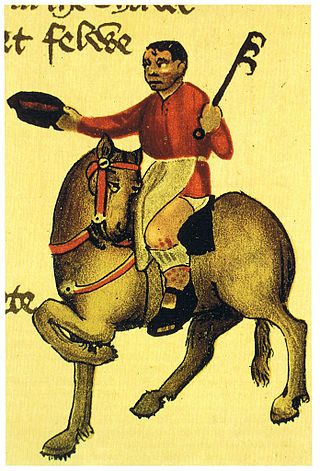
"The Cook's Tale" is one of the Canterbury Tales by Geoffrey Chaucer. It breaks off after 58 lines and was presumably never finished, although some scholars argue that Chaucer deliberately left the tale unfinished.
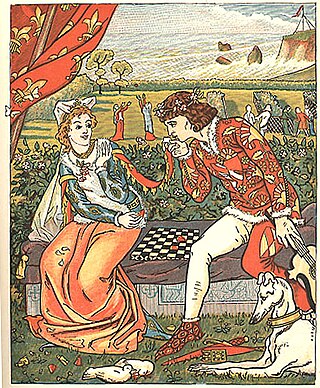
"The Franklin's Tale" is one of The Canterbury Tales by Geoffrey Chaucer. It focuses on issues of providence, truth, generosity and gentillesse in human relationships.

The General Prologue is the first part of The Canterbury Tales by Geoffrey Chaucer. It introduces the frame story, in which a group of pilgrims travelling to the shrine of Thomas Becket in Canterbury agree to take part in a storytelling competition, and describes the pilgrims themselves. The Prologue is arguably the most familiar section of The Canterbury Tales, depicting traffic between places, languages and cultures, as well as introducing and describing the pilgrims who will narrate the tales.

"The Manciple's Tale" is part of Geoffrey Chaucer's The Canterbury Tales. It tends to appear near the end of most manuscripts of the poem, and the prologue to the final tale, "The Parson's Tale", makes it clear it was intended as the penultimate story in the collection. The Manciple, a purchasing agent for a law court, tells a fable about Phoebus Apollo and his pet crow, which is both an origin myth explaining the crow's black feathers and a moralistic injunction against gossip.

"The Friar's Tale" is a story in The Canterbury Tales by Geoffrey Chaucer, told by Huberd the Friar. The story centers on a corrupt summoner and his interactions with the Devil. It is preceded by The Wife of Bath's Tale and followed by The Summoner's Tale.

"The Second Nun's Tale", written in late Middle English, is part of Geoffrey Chaucer's The Canterbury Tales. Narrated by a nun who remains unnamed, it is a hagiography of the life of Saint Cecilia.

"The Shipman's Tale" is one of The Canterbury Tales by Geoffrey Chaucer.
The Legend of Good Women is a poem in the form of a dream vision by Geoffrey Chaucer during the fourteenth century.

Projection was the ultimate goal of Western alchemy. Once the philosopher's stone or powder of projection had been created, the process of projection would be used to transmute a lesser substance into a higher form; often lead into gold.
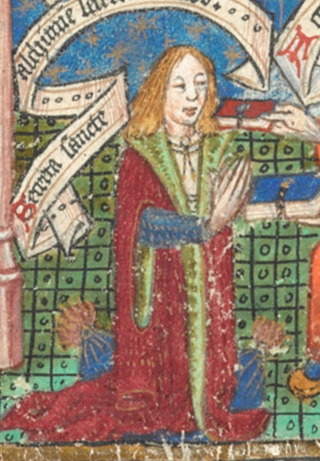
Thomas Norton was an English poet and alchemist best known for his 1477 alchemical poem, The Ordinal of Alchemy.
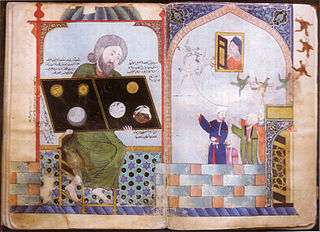
Muḥammad ibn Umayl al-Tamīmī, known in Latin as Senior Zadith, was an early Muslim alchemist who lived from c. 900 to c. 960 AD.
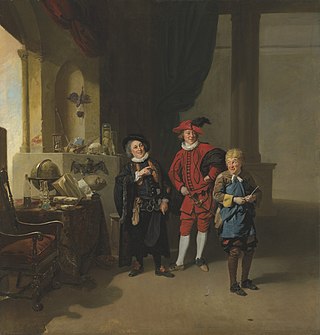
Alchemy has had a long-standing relationship with art, seen both in alchemical texts and in mainstream entertainment. Literary alchemy appears throughout the history of English literature from Shakespeare to modern Fantasy authors. Here, characters or plot structure follow an alchemical magnum opus. In the fourteenth century, Chaucer began a trend of alchemical satire that can still be seen in recent fantasy works like those of Terry Pratchett.
The Prologue and Tale of Beryn are spurious fifteenth century additions to Geoffrey Chaucer's Canterbury Tales. They are both written in Middle English.
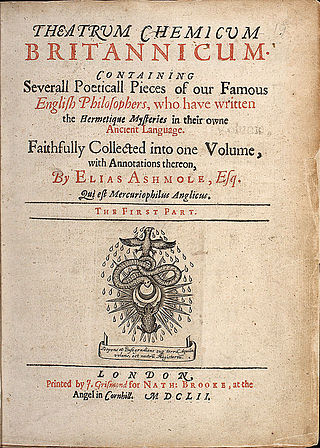
Theatrum Chemicum Britannicum first published in 1652, is an extensively annotated compilation of English alchemical literature acquired by Elias Ashmole. The book preserved and made available many works that had previously existed only in privately held manuscripts. It is the first part of a planned multi-volume set. It contains the rhyming verse of many alchemists, poets, mathematicians &c, such as Thomas Norton, George Ripley, Geoffrey Chaucer, John Gower, John Dee, Edward Kelley, John Lydgate, John Dastin and William Backhouse.

The Squire is a fictional character in the framing narrative of Geoffrey Chaucer's Canterbury Tales. He is squire to the Knight and is the narrator of The Squire's Tale or Cambuscan. The Squire is one of the secular pilgrims, of the military group. The Knight and the Squire are the pilgrims with the highest social status. However his tale, interrupted as it is, is paired with that of the Franklin. The Squire is a candidate for the interrupter of The Host in the epilogue of the Man of Law's Tale.



















